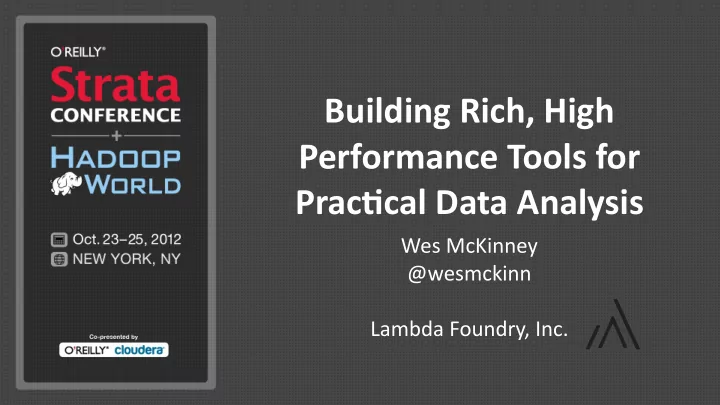

Building ¡Rich, ¡High ¡ Performance ¡Tools ¡for ¡ Prac7cal ¡Data ¡Analysis Wes ¡McKinney @wesmckinn Lambda ¡Foundry, ¡Inc.
Talk ¡Overview Background Goals Key ¡Ingredients Examples
My ¡Background MIT ¡’07, ¡ ¡AQR ¡2007-‑2010, ¡ ¡LF ¡2012-‑ ¡ Lead ¡developer ¡of ¡pandas ¡ ¡(Python ¡library)
Goals Data ¡Tooling
Goals Big™ ¡and ¡Small™ ¡Data
Goals Simplify ¡Data ¡Wrangling
Goals User ¡interface ¡design
User ¡interface ¡design i.e. ¡“how ¡do ¡I ¡do ¡what ¡ I ¡need?”
API ¡Design
API ¡Design “Fits ¡your ¡brain” “All ¡my ¡funcPons ¡have ¡17 ¡arguments”
Syntax Matters
API ¡Design (($:@(<#[),(=#[),$:@(>#[))({~ ?@#))^:(1<#) {f:*x@1?#x;:[0=#x;x;,/(_f x@&x<f;x@&x=f;_f x@&x>f)]} Text Text
API ¡Design J (($:@(<#[),(=#[),$:@(>#[))({~ ?@#))^:(1<#) {f:*x@1?#x;:[0=#x;x;,/(_f x@&x<f;x@&x=f;_f x@&x>f)]} Text Text K/Kona
API ¡Design >>>>>>>>,[>,]<[[>>>+<<<-]>[<+>-]<+<]>[<<<<<<<<+>>>>>>>>-]<<<<<<<<[[>>+ >+>>+<<<<<-]>>[<<+>>-]<[>+>>+>>+<<<<<-]>[<+>-]>>>>[-<->]+<[>->+<<-[>>- <<[-]]]>[<+>-]>[<<+>>-]<+<[->-<<[-]<[-]<<[-]<[[>+<-]<]>>[>]<+>>>>]>[-< <+[-[>+<-]<-[>+<-]>>>>>>>>[<<<<<<<<+>>>>>>>>-]<<<<<<]<<[>>+<<-]>[>[>+> >+<<<-]>[<+>-]>>>>>>[<+<+>>-]<[>+<-]<<<[>+>[<-]<[<]>>[<<+>[-]+>-]>-<<- ]>>[-]+<<<[->>+<<]>>[->-<<<<<[>+<-]<[>+<-]>>>>>>>>[<<<<<<<<+>>>>>>>>-] <<]>[[-]<<<<<<[>>+>>>>>+<<<<<<<-]>>[<<+>>-]>>>>>[-[>>[<<<+>>>-]<[>+<-] <-[>+<-]>]<<[[>>+<<-]<]]>]<<<<<<-]>[>>>>>>+<<<<<<-]<<[[>>>>>>>+<<<<<<< -]>[<+>-]<+<]<[[>>>>>>>>+<<<<<<<<-]>>[<+>-]<+<<]>+>[<-<<[>+<-]<[<]>[[< +>-]>]>>>[<<<<+>>>>-]<<[<+>-]>>]<[-<<+>>]>>>]<<<<<<]>>>>>>>>>>>[.>]
API ¡Design Brainf*** >>>>>>>>,[>,]<[[>>>+<<<-]>[<+>-]<+<]>[<<<<<<<<+>>>>>>>>-]<<<<<<<<[[>>+ >+>>+<<<<<-]>>[<<+>>-]<[>+>>+>>+<<<<<-]>[<+>-]>>>>[-<->]+<[>->+<<-[>>- <<[-]]]>[<+>-]>[<<+>>-]<+<[->-<<[-]<[-]<<[-]<[[>+<-]<]>>[>]<+>>>>]>[-< <+[-[>+<-]<-[>+<-]>>>>>>>>[<<<<<<<<+>>>>>>>>-]<<<<<<]<<[>>+<<-]>[>[>+> >+<<<-]>[<+>-]>>>>>>[<+<+>>-]<[>+<-]<<<[>+>[<-]<[<]>>[<<+>[-]+>-]>-<<- ]>>[-]+<<<[->>+<<]>>[->-<<<<<[>+<-]<[>+<-]>>>>>>>>[<<<<<<<<+>>>>>>>>-] <<]>[[-]<<<<<<[>>+>>>>>+<<<<<<<-]>>[<<+>>-]>>>>>[-[>>[<<<+>>>-]<[>+<-] <-[>+<-]>]<<[[>>+<<-]<]]>]<<<<<<-]>[>>>>>>+<<<<<<-]<<[[>>>>>>>+<<<<<<< -]>[<+>-]<+<]<[[>>>>>>>>+<<<<<<<<-]>>[<+>-]<+<<]>+>[<-<<[>+<-]<[<]>[[< +>-]>]>>>[<<<<+>>>>-]<<[<+>-]>>]<[-<<+>>]>>>]<<<<<<]>>>>>>>>>>>[.>]
“A ¡user ¡interface ¡can ¡handle ¡only ¡so ¡ much ¡complexity ¡or ¡it ¡becomes ¡ unusable.” Guido ¡van ¡Rossum
Key ¡Ingredients API ¡/ ¡User ¡interface ¡design ¡ Data ¡types Arrays Data ¡structures Efficient ¡Algorithms
Arrays Blob ¡of ¡bytes ¡as ¡mulPdimensional ¡array All ¡elements ¡same ¡type ImplementaPons: ¡NumPy ¡(Python), ¡J ¡/ ¡APL, ¡R, ¡MATLAB, ¡... Scalar Vector Matrix Cube/Hypercube Rank ¡0 Rank ¡1 Rank ¡2 Rank ¡> ¡2
Arrays Loopless ¡programming - ¡VectorizaPon - ¡BroadcasPng No-‑copy ¡views
(Some) ¡Basic ¡data ¡types Integer FloaPng ¡point ¡/ ¡Complex Characters ¡and ¡Strings ¡(ASCII ¡or ¡Unicode) Date ¡and ¡Pme Box ¡/ ¡“Object”
(Some) ¡Basic ¡data ¡types Integer FloaPng ¡point ¡/ ¡Complex Characters ¡and ¡Strings ¡(ASCII ¡or ¡Unicode) Date ¡and ¡Pme Box ¡/ ¡“Object” Categorical ¡/ ¡enumeraPon ¡(R: ¡“factors”) Record ¡or ¡structure ¡(one ¡or ¡more ¡of ¡the ¡above)
Data ¡types Also, ¡any ¡values ¡can ¡be ¡“missing” ¡(NA) Text
Risks Stuck ¡in ¡type ¡soup generic number integer unsigned int signed int inexact floating complex character string_ unicode_ bool_ object_
Risks Actually ¡it’s ¡more ¡like integer unsigned int uint8 uint16 uint32 uint64 signed int int8 int16 int32 int64
Data ¡types ¡and ¡users Control ¡over ¡machine ¡representaPon - Treacherous, ¡but ¡oben ¡necessary Simplicity ¡vs. ¡power ¡and ¡control
Tables A ¡sequence ¡of ¡arrays, ¡each ¡with ¡own ¡data ¡type 0 1 2 3 4 5
Tables A ¡sequence ¡of ¡arrays, ¡each ¡with ¡own ¡data ¡type Common ¡simplificaPon: ¡only ¡1-‑dimensional ¡arrays 0 1 2 3 4 5
Table ¡and ¡Array ¡Axis ¡Labeling One ¡or ¡more ¡categorical ¡arrays ¡per ¡axis Numerous ¡uses 0 1 2 3 4 5 “Row labels” 1 2 A Text 3 4 1 2 B 3 4
Table ¡and ¡Array ¡Axis ¡Labeling
Table ¡and ¡Array ¡Axis ¡Labeling ....
This ¡predicates ¡on ¡the ¡ existence ¡of ¡sane ¡APIs ¡
Some ¡“primi7ve” ¡opera7ons Align ¡/ ¡join ¡/ ¡merge ¡/ ¡“Vlookup” Concatenate Reshape, ¡Stack/fold, ¡Unstack/unfold, ¡Pivot, ¡Melt Subset: ¡Drop ¡rows, ¡columns Elementwise ¡transforms: ¡map, ¡replace, ¡fill, ¡string ¡stuff Group ¡By: ¡Apply, ¡Aggregate, ¡Transform, ¡Cut, ¡... Set ¡operaPons: ¡Unique, ¡deduplicate, ¡is-‑in
Example: ¡concatena7on leb ¡(prices) right ¡(volume)
Example: ¡concatena7on result = concat([left, right], axis=1, keys=[‘price’, ‘volume’])
Example: ¡stack/fold result.stack(0)
Under ¡the ¡hood Array ¡/ ¡vector ¡operaPons Efficient ¡data ¡movement Hash ¡sets ¡and ¡tables SorPng ¡algorithms RelaPonal ¡algebra
Example: ¡group-‑by H. ¡Wickham ¡“The ¡Split-‑Apply-‑Combine ¡Strategy ¡for ¡Data ¡Analysis” Beyond ¡relaPonal ¡databases SELECT key1, key2, key3, MEAN(value1), STD(value2) FROM table GROUP BY key1, key2, key2
Example: ¡group-‑by In ¡pseudocode grouped = table.groupby(key_list) result = grouped.apply(function)
Example: ¡group-‑by In ¡pseudocode Arrays, functions, column names, ... grouped = table.groupby(key_list) result = grouped.apply(function)
Example: ¡group-‑by In ¡pseudocode Arrays, functions, column names, ... grouped = table.groupby(key_list) result = grouped.apply(function) Preferably, any function accepting an array or table
Recommend
More recommend